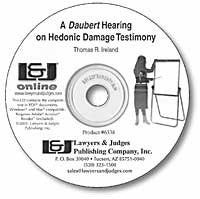
Ladders: Safety and Litigation
- Author: Jon R. Abele, Cindy A. LaRue
- ISBN 10: 1-930056-91-5
- ISBN 13: 978-1930056-91-6
- Copyright Date Ed: May 18, 2010
- Pages: 244 pages
- Binding Information: Paperback
- Size: 6 ✕ 9 Inches (US)
Every ladder injury case will benefit from this book.
Ladders, in the home and the workplace, are the cause of thousands of injuries and even deaths each year, despite new developments and warnings designed to enhance ladder safety. Statistics reported by the National Safety Council indicate that there were over 185,000 injury-related emergency department visits in 2006 associated with ladders and close to 400 deaths caused by falling from ladders or scaffolding.
Ladders: Safety and Litigation approaches all aspects of ladder use using a human factors/ergonomics system perspective, with a focus on the three elements involved: the person, ladder, and environment. This book addresses the many facets of ladder use, including safety issues both at home and in the workplace.
You will learn about the various standards that have been developed for ladder design, explaining how common factors lead to incidents. You can also review checklists included to assist you in inspecting ladders and investigating ladder incidents.
This indispensable text for all ladder cases further covers the legal aspects, such as if there is any legal recourse for the injuries sustained in a ladder accident, allowing you to quickly evaluate a case and determine which accidents will justify a full forensic investigation. You must be able to evaluate the facts in light of the applicable law of the jurisdiction.
The fact that using a ladder can be dangerous does not mean that everyone who has been injured in a ladder accident case cannot recover damages for the injuries. It means that the attorney has to take the time to examine all aspects of the accident and then, after he knows the facts of the accident, make a determination on whether the client has a valid claim. This book will prepare you to make that decision.
If there is a valid case, it will also help you determine which theory of liability to allege, who to name as the defendant and how best to prove the plaintiff’s cause of action. There are numerous choices the attorney can make with each of these issues. This book will provide the attorney with the information needed to make an informed choice on how to proceed in the most effective manner. The attorney who is armed with the most information is in the best position to prevail when representing an injured client.
A client interview checklist is provided that allows the attorney to gather the necessary information from a potential client at the initial interview. Having all this information at the beginning saves time and effort by quickly sorting the ladder accident case into a probable cause of action or a case that has no hope of success.
This book is also available as an E-book. Click here to purchase and download:
Topics Include:
- Ladder selection
- Ladder design
- Body movement of ladder users
- Ladder use
- Ladder care and upkeep
- Ladder safety
- Workplace ladder use
- Common incident patterns
- Human factors/ergonomics and safety developments
- Theory of liability
- Proper party defendant
- Design defects
- Manufacturing defects
- Better alternative available
- Testing prior to sale
- Misuse
- Open and obvious danger
- Proximate cause
- Contributory negligence
- State of the art defense
- Warnings and regulations
- Experts
- Ladder nomenclature and definitions
- Ladder accident case checklists
Table of Contents
Part I: Safety Aspects
Chapter 1: Ladder Selection
Chapter 2: Ladder Design
Chapter 3: Body Movement of Ladder Users
Chapter 4: Ladder Use
Chapter 5: Ladder Care
Chapter 6: Ladder Safety
Chapter 7: Workplace Ladder Use
Chapter 8: Common Incident Patterns
Chapter 9: Human Factors/Ergonomics and Safety Developments
Part II: Legal Aspects
Chapter 10: Theory of Liability
Chapter 11: Proper Party Defendant
Chapter 12: Design Defect
Chapter 13: Manufacturing Defect
Chapter 14: Better Alternative Available
Chapter 15: Testing Prior to Sale
Chapter 16: Misuse
Chapter 17: Open and Obvious Danger
Chapter 18: Visual Confusion
Chapter 19: Proximate Cause
Chapter 20: Presumptions
Chapter 21: Contributory Negligence
Chapter 22: State of the Art Defense
Chapter 23: Warnings
Chapter 24: Regulations
Chapter 25: Limiting Factors
Chapter 26: Experts
Chapter 27: Conclusion to Legal Aspects
Appendix A: Ladder Nomenclature and Definitions
Appendix B: Ladder Incident: Characteristics of Ladder
Appendix C: Ladder Incident: Characteristics of Incident and Environment
Appendix D: Ladder Incident: Characteristics of User
Appendix E: Occupational Safety and Health Administration: Stairways and Ladders, A Guide to OSHA Rules
Appendix F: Code of Federal Regulations
Appendix G: Checklist for Ladder Accident Cases




